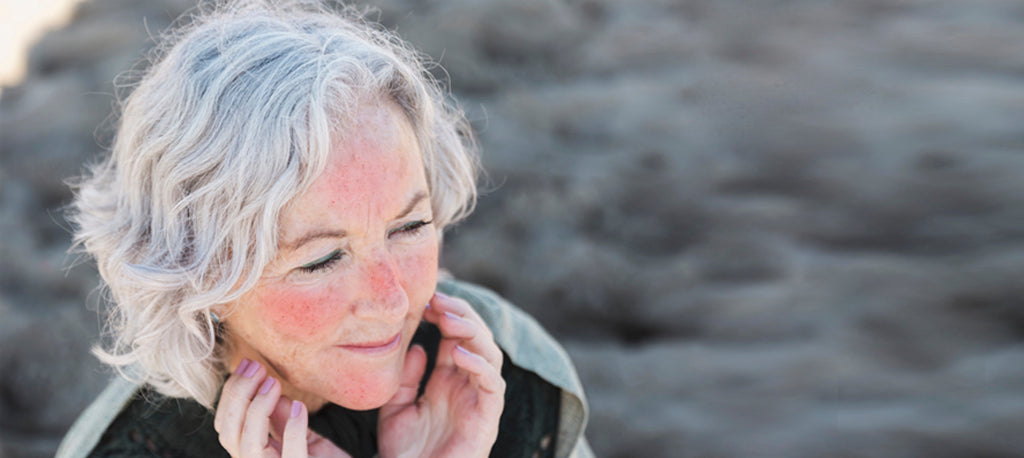
One interesting alternative to standard options is light therapy, as it works well for a variety of skin conditions, from eczema, to rosacea, and more. But which variety is best? Laser therapy, blue light, and red light all can work, but some are more effective, or affordable, than others. Below we’ll reveal the winning selections, as well as provide some brief context around the impact of rosacea and other current, common treatments.
The Impact of Rosacea
Rosacea is a common chronic inflammatory skin disorder that manifests primarily on the face. It may be partially genetic as it is more prevalent among fair-skinned people among an estimated 14 million people in the U.S. who suffer from the disorder. However, rosacea is sometimes misdiagnosed as eczema, allergies, or acne, so the disorder could be affecting a larger portion of the population than has been confirmed.
The causes behind this puzzling condition are not fully understood and unfortunately, there’s currently no permanent cure. It is clear however, that the condition will worsen if left untreated. And since it is so visible, rosacea can cause severe psychological distress. In fact, depression, anxiety, loss of self-esteem and social phobias are common emotional effects of rosacea. Patients can also be affected by social stigmas that can include being perceived as alcoholics or as having poor hygiene. All together, rosacea can cause quite a few problems, but unfortunately, it can also be difficult to treat.
Current Treatments for Rosacea
Treating rosacea requires a focus on alleviating symptoms, usually by using a combination of enhanced skin care practices and prescription medications. However, since none of these methods present a cure, recurrence of symptoms is frustratingly common.

Good self-care practices are at the heart of rosacea treatment. Methods include:
- Identifying and avoiding environmental and dietary triggers;
- Using a UVA/UVB blocking broad-spectrum sunscreen;
- Protecting the face in cold weather; and
- Using mild cleansers and natural moisturizers.
Many patients also use makeup to reduce the appearance of redness, but this must be done with caution as allergic or other skin reactions may occur.
Alternative medicine such as facial massages, moderate caffeine intake (iced, not hot), and meditation can also be effective because they help alleviate stress, which can worsen symptoms. Emu oil and oregano oil have also been touted as ways to treat rosacea, but their efficacy is not confirmed.
Topical prescription drugs can help by constricting blood vessels, which reduces redness and provides relatively fast, but temporary, results. Additionally, bumps and pimples can be managed through the use of prescription oral antibiotics and acne medications.
Overall though, none of these treatments is reliably effective for all sufferers, and when they work, they’re not particularly long-lasting. In the absence of a cure and with the ongoing expense of over-the-counter and prescribed treatments, many sufferers are searching for alternative therapies. If this is you, light therapy is worth a second look.
Light Treatment for Rosacea
LED light therapy for rosacea is available with a range of options, including laser resurfacing, yellow, green, blue, or red varieties. Each type of light has a slightly different application, but overall they can be used to remove skin thickening, reduce redness, and ease discomfort. Let’s start with the most popular option: laser resurfacing.
Phototherapy as an Alternative: Red Light Therapy for Rosacea
A more affordable way to treat rosacea is light therapy, where the affected skin is exposed to devices that emit different wavelengths of light. Every color of light corresponds to a different wavelength, red light is the only one that can help rosacea.
All other wavelengths—including amber, green, and blue light—only penetrate the skin at the very surface level. This makes them great for acne, mild wrinkles, and other minor skin blemishes, but no serious conditions. For that, you’d have to look to red light therapy.
Red light therapy involves exposing the skin to strong sources of visible red light (610-700nm), typically through LED bulbs. It’s important to note up front that red light can not be considered a cure for rosacea, because there are no studies that have examined this particular combination.
However, it does help reduce general skin redness and promotes healthy cellular function, so it’s worth a second look as a secondary, supporting treatment. Note however, that many studies recommend using red light therapy in the form of intense pulsed light, but the jury is still out on the efficacy of this application.
The reason red light is effective is that it penetrates below the surface of the skin, and stimulates improved cellular function. This makes it effective at treating a variety of skin conditions, and as a bonus, there are no known side effects.
Benefits of Red Light Therapy include:
- Stimulating scalp hair growth
- Treating psoriasis and eczema
- Toning aging skin by stimulating the production of collagen for improved skin elasticity, and a youthful appearance
- Reducing acne breakouts and inflammation
- Reduction of fine lines, sagging skin, sun damage, and wrinkles
- Accelerated skin wound healing
- Healing of non-melanoma skin cancers


